Chinese Spring Festival 2015: Tradition & History
Happy New Year, we are back.
i receiver a lot of letter from our customers these days ,as some of our customers are interested in our culture , especially the Chinese New Year, here i find a very detailed introduction about our tradion and history of Chinese New Year. hope you like it,
the widely known as Chinese New Year in the West , also called Spring Festival in China, is the most important traditional festival, and most important celebration for families in China. It is an official public holiday, during which most Chinese have 8 days off work.
The Date Is Based on the Lunar Calendar
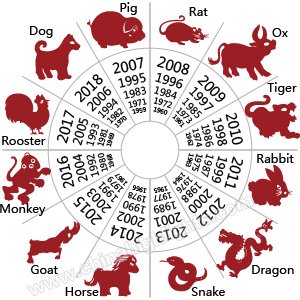
Chinese New Year 2015 begins on Thursday 19 February, and end on 5 March. It is day one month one of the Chinese lunar calendar, and its date in January or February varies from year to year (always somewhere in the period January 21 to February 20).
The Chinese lunar calendar is associated with the Chinese zodiac, which has 12 animal signs: rat, ox, tiger, rabbit, dragon, snake, horse, goat, monkey, Rooster, dog, and pig. Each animal represents a year in a 12-year cycle, beginning on Chinese New Year’s Day. 2015 is a year of the goat.
2015 — a Goat Year (“Wood Goat”)
2015 is a year of the “Goat” according to the Chinese 12-year animal zodiac (Heavenly Stem) cycle. If you were born in a Goat year you should be particularly careful in 2015, according to Chinese astrology. See more on how to be lucky in the year of the Goat.
2015 is furthermore a year of the “Wood Goat”, according to Chinese Five Element (Earthly Branch) Theory. A “Wood Goat” year occurs every 60 years. See a Five Element Character and Destiny Analysis for People Born in a Year of the Goat.
What China’s New Year Festival Is
The Longest Public Holiday in China
In 2015 most Chinese will be off work from Wednesday, February 18 (New Year’s Eve) to Tuesday, February 24 (the 6th day of Chinese New Year).
Officially only the first three days of Chinese New Year (February 19–21, 2015) are statutory holiday. Chinese New Year’s Eve and three more days are always added to give seven consecutive days of holiday. These four extra days are taken from weekends: the weekend closest to the statutory holiday is included, while the Sunday before (February 15, 2015) and the Saturday after (February 28, 2015) are worked.
A Festival for Families to Be Together
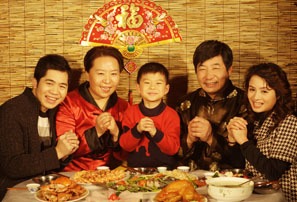
Chinese New Year is a time for families to be together. Wherever they are, people come home to celebrate the festival with their families.
The New Year’s Eve dinner is called Reunion Dinner, and is believed to be the most important meal of the year. Big families – families of several generations sit around round tables and enjoy the food and time together.
The importance of reunion during the Spring Festival has caused somedifficult situations for China’s increasingly women’s lib. couples in recent years, who want to go to different homes for the festival. Divorce has happened because of disputes over going to whose home for the festival. (In the past a married couple would always go to the man’s home unless the husband joined the wife’s family at marriage.)
How Chinese New Year Is Celebrated Traditionally
Spring Festival History
The Spring Festival has a history of more than 4,000 years. It is said that it originated from a belief in deities that had to be sacrificed to every year. When the solar terms changed, dictating farming activities, especially at the end of a year, people would sacrifice to the deities and pray for a good harvest.
Rarely Seen Cultural Activities to See
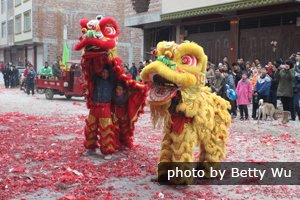
Many cultural activities occur during the festival. Rural areas and small towns retain more traditional celebrations, such as setting offfirecrackers, ancestor worship, and dragon dances. Setting off firecrackers and fireworks are common during the Spring Festival season all over China; dragon dances and ancestor worship less so in the city.
At temple fairs in many Chinese cities traditional performances can be seen: dragon dances, lion dances, and performances representing palace events like an emperor’s wedding. A great variety of traditional Chinese products are on offer there, and strange Chinese snacks, rarely seen the rest of the year. Beijing’s temple fairs are held in parks from the first day of the lunar year to the Lantern Festival.
In North China people perform various versions of the Rice Sprout Song(扭秧歌 Niǔyāng Gē /nyoh-yang ger/ ‘twist sprout song’), a traditional Chinese dance performed by a group of colorfully-dressed women and men.
Lucky Decorations Everywhere
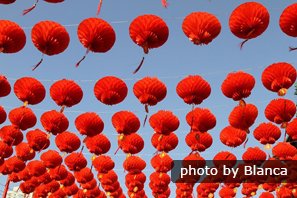
Every street, building, and house is decorated with red. “Red” is the main color for the festival, as it is believed to be an auspicious color. Red lanterns hang in streets; red couplets are pasted on doors; banks and official buildings are decorated with red New Year pictures depicting images of prosperity.
As 2015 is the year of goat, decorations related to goats will be commonly seen. There are red goat dolls for children and New Year paintings with goats on. Read more on Chinese New Year Decorations.
Red Envelopes — the Most Popular Gifts
Like Christmas in the West, people exchange gifts during the Spring Festival. The most common gifts are red envelopes. Red envelopes have money in, and are given to children and (retired) seniors. It is not a customs to give red envelopes to (working) adults.Read more on Chinese New Year Gift Ideas
Foods with Lucky Meanings Are Eaten
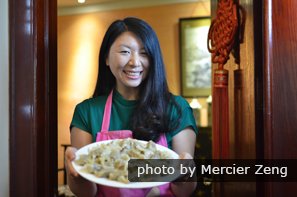
Certain foods are eaten during the festival because of their symbolic meanings, based on their names or appearance.
Fish is a must for Chinese New Year as the Chinese word for fish (鱼 yú /yoo/) sounds like the word for surplus (余 yú). Eating fish is believed to bring a surplus of money and good luck in the coming year.
Another traditional Chinese New Year food is Chinese dumplings. Because the shape of Chinese dumplings looks like silver ingot – a kind of ancient Chinese money, Chinese people believe eating dumplings during the New Year festival will bring more money and wealth for the coming year.
Other New Year food includes spring rolls, glutinous rice cakes and Sweet Rice Balls.
A Season of Superstitions — How to be Lucky in 2015…

Chinese people believe that, as the Spring Festival is the start of a new year, what you do then will affect your luck in the coming year. There are many taboos for the Spring Festival season. These taboos usually apply up to a month before the festival and continue to the end of the festival (day 15, the Lantern Festival). They are strictly followed in rural areas by the older generations, but the younger generations and people in urban areas may not know them.
- Some Chinese people believe that they mustn’t do cleaning and wash their hair in the first three days as that will sweep/wash away good luck.
- A cry of a child is believed to bring bad luck to the family, so the young are placated fastidiously.
- To ask for a loan is a big “no-no”.
- Another interesting thing is the red underwear. You will see red underwear sold at supermarkets and street markets. Red is believed to ward off bad luck and misfortune. For the people born in a year of the goat (1919, 1931, 1943, 1955, 1967, 1979, 1991, 2003), red underwear is a must for 2015.
- To pray in a temple during the Chinese New Year is said to be blessed, and will lead to a smooth coming year. In Shanghai, China’s biggest city, thousands flock to Longhua Temple, the city’s biggest temple, praying for good fortune. Read more on Things You Cannot Do During Chinese New Year.
if you want to know more about Chinese new year, please check
http://www.chinahighlights.com/travelguide/special-report/chinese-new-year/
thanks.